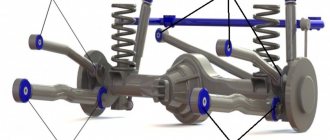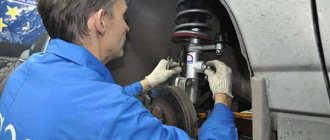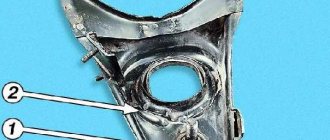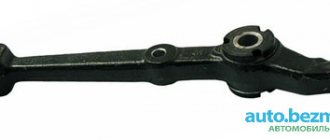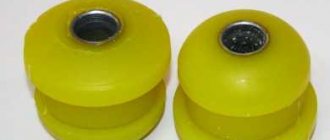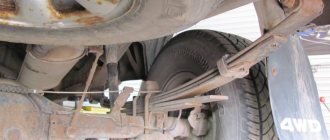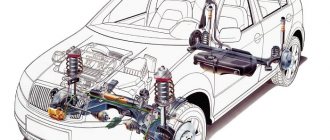“Silent” in translation means “quiet”. This part is a “set” consisting of a bushing and a cylinder, between which polyurethane or rubber is filled. The product is widely used as an “intermediary” between car body parts and suspension elements. Another purpose of silent blocks is to mount engines and gearboxes. The task of rubber-metal bushings is to dampen vibrations, vibrations, and shocks that are inevitable when moving on roads, especially Russian ones. The products help save expensive car components and extend their service life. These parts, provided they are original, last quite a long time: 100 thousand km or more. But it is recommended to check them every 50 thousand km. How to change silent blocks? You can do this yourself or at a car service center in Moscow. It is better not to delay the restoration of normal driving performance of the car.
What happens if the silent blocks are not changed on time?
When the part wears out, a gradually increasing play appears (in the block seat). As a result, the sleeve hole is also developed. This is fraught with:
- pulling the car to the side at high speed;
- increased and uneven tire wear;
- poor handling, especially noticeable when cornering;
- the appearance of a feeling of discomfort when moving, because hitting even small obstacles will bring unpleasant sensations.
Useful tips
It is important to understand that malfunctions or wear of individual parts and components in the suspension device can have a strong impact on the comfort and controllability of the vehicle as a whole. In other words, if the rear silent blocks of the front levers are worn out or there are problems with the silent blocks of the rear suspension, the car may become less responsive to the steering wheel, controllability and stability will deteriorate, etc.
So, if at low speeds these negative consequences are not very noticeable, at medium or high speeds driving with failed silent blocks can be dangerous. Moreover, for fans of high-speed driving, it is completely recommended to replace standard rubber silent blocks with suitable polyurethane ones.
This will not only increase the service life of the elements, but also improve controllability and increase stability. The main thing is to choose the right replacement parts, as well as perform the installation efficiently. If you do not have the experience and tools, it is better to immediately abandon attempts at self-repair and entrust the procedure to experienced specialists.
We also recommend reading the article about what a ball joint is. From this article you will learn about the purpose, principles of operation, as well as signs of malfunction, frequent problems and features of replacing ball joints in the chassis of a car. We also note that if the car has a mileage of more than 60-70 thousand km. and chassis repairs have not been carried out previously, in this case, in addition to silent blocks, special attention should be paid to stabilizers and stabilizer struts, as well as stabilizer bushings.
If handling deteriorates, it will not be superfluous to check the shock absorbers. Only if all components and parts of the suspension are in full working order does the car receive the necessary stability, swaying, noise, vibration, etc. disappear. It also happens that even with a fully serviceable suspension, only replacing soft (for example, oil struts) with stiffer gas-oil shock absorbers allows you to qualitatively solve the problem and get the desired result.
What is used to make silent blocks?
Most often it is rubber, but recently polyurethane has begun to be used more and more often. If you have the opportunity to choose, you should give preference to him. The main advantage of polyurethane silent blocks is a longer service life. Such products also dampen vibrations much more effectively and actively “resist” being squeezed out of their sockets.
Advantages and disadvantages
The main advantages arise from the purpose of rubber-metal hinges:
- maximum quiet and comfortable operation of the unit;
- no maintenance requirements;
- there is no need to use lubricant, which deteriorates and develops over time;
- simplicity and low cost of design;
- diagnostic clarity that does not require qualified personnel;
- easy replacement at the end of its service life;
- the ability to set properties by selecting the material of the elastic element.
RMS competitors include all kinds of ball and cylindrical joints, which do not have the disadvantages inherent in silent blocks:
- Excessive freedom of movement in the hinge, characteristic of the RMS, is not always useful;
- cheap materials quickly age and deteriorate;
- rubber bushings do not work well at too high and low temperatures;
- strength under load is strongly related to the rigidity of the unit, and attempts to implement a compromise lead to an increase in weight, dimensions and cost;
- operating angles and the ability for relative movement of the clips over a wide range are limited.
On cars where control accuracy is more important than comfort and low price of the suspension, RMS have limited use. They are often replaced with ball joints (BJ) during sports car tuning.
How to choose a tool to replace silent blocks
In addition to the traditional set - pry bar, keys, hammer - you will need a special tool. The best option is to purchase a professional puller. This is a hydraulic device that allows you to replace a part in the most gentle way possible, without causing damage to it. Such tools are used in all technical centers. Pullers help to screw (unscrew) a special mechanism into the inside of the part, raising or lowering it. As a result, replacement of spare parts occurs evenly, without distortions, and it is much easier to restore the functionality of the entire lever.
Video
This video shows how to make a silent block remover and how to work with it.
How to change silent blocks without a puller.
How to change silent blocks on the “classic” VAZ 2101, 2102, 2103, 2104, 2105, 2106, 2107.
How to make a puller for VAZ 2113, 2114, 2115.
How to make a puller for removing and installing rubber-metal hinges on Skoda Fabia, Skoda Rapid, VW Polo Sedan cars.
0
Author of the publication
offline 1 month
How to make a device with your own hands
The simplest option is to use a “27” head, which will serve as a mandrel for pressing. A small hydraulic jack or vice will also work. In the first case, you can try to squeeze out or press in the silent block right in place. When using a vice, the part will have to be removed. Other options for homemade “pullers”:
- bolt M20;
- a pair of tightening cups with washers;
- threaded rod;
- a piece of pipe whose diameter exceeds the diameter of the silent blocks.
Such “tools” work simply. Take a bushing and place it on the side where the silent block will be pressed out. A threaded bolt is installed in the hole. Next, they begin to tighten the nuts and the washers are gradually brought together: one of them presses the product out of the seat. Still, it is worth noting: the replaced spare part will last longer if the operation was carried out in a car service center.
Selecting new parts
Before replacing worn silent blocks, you need to select new ones and buy them. Today there are many choices of these parts.
Types of silent blocks of front levers:
- rubber;
- polyurethane.
Before buying new ones, the following question arises: which silent blocks to take, rubber (rubber) or polyurethone.
Polyurethane ones have a longer service life, they last 3-5 times longer. But, they are more expensive. The polished tan vibration isolator is less likely to be deformed and squeezed out of the grooves of the seat.
Advice! In case of increased vehicle operation, it is better to install polyurethane ones. For low mileage mode, ordinary rubber silent blocks will be sufficient. Both types of these parts are produced by many manufacturers. The main thing is not to take the cheapest ones.
Before purchasing, you should check whether they are suitable for your particular make and model of car.
Replacement of silent blocks of front levers
If you have a puller, no matter whether professional or homemade, replacement occurs relatively quickly. The progress of the operation can be seen in the video, which is easy to find on the Internet. It is much more interesting to consider the method of dismantling and installing parts without special tools on a front-wheel drive car. How to replace silent blocks? To do this you need:
- Drive the car onto an overpass or inspection hole (you can also use a jack). The engine crankcase protection will have to be removed.
- Unscrew the bolts securing the arms.
- Using a “17” wrench, unscrew the nut securing the stabilizer (strut) to the lever;
- The bolt will have to be knocked out of the stabilizer.
- Remove the wheel.
- To unscrew the extension nut, you will need a “24” wrench. If things get tough, use a wire brush, WD
- To remove the lever, remove the ball joint bolts. If problems arise, remove the lever directly with the crab by unscrewing the 3 bolts securing it to the body. The nut can then be unscrewed using a chisel or by heating.
- Now you can change the silent block of the extension, for which a good old chisel will do.
- You can press silent blocks in a vice. If they do not go in completely, place the lever on a level place and finish the job with a hammer.
- When the stretching is done, you can move on to the lever. A puller will do here (the process is described above).
- The new part is installed using a pressing tool. Pre-lubricate the silent block with liquid soap.
Why do you need a silent block?
The silent block is otherwise called a rubber-metal hinge. Externally, the part resembles a cylinder and consists of three main components:
- The outer part - steel is used for its manufacture; it also has seating elements: stiffeners and a shell.
- The core is a solid metal sleeve.
- Clearance - this space between two metal elements is filled with an elastic material (rubber or polyurethane).
The operation of the silent block is as follows. The inner sleeve is clamped on all sides by elastic material, which prevents its rotation. The outer bushing is in the same conditions and does not rotate relative to the rubber or polyurethane insert.
However, when a torsional force of a certain intensity occurs, the bushings can rotate relative to each other at a small angle, due to the elasticity of the filler. This limits the turning radius of the lever, but for the full functioning of the suspension this radius is quite enough. This rubber-metal part can also be called a dry hinge, since it performs its duties without lubrication. Its operation is ensured precisely due to the elasticity of the insert between the metal bushings.
In other words, the task of silent blocks comes down to dampening vibrations that inevitably arise when the car is moving. In addition, they prevent their spread between suspension units.
The car suspension on each side is connected to the body at 2 or 3 points. In the first case, it is attached to the lever and the strut, and in the second - to two levers and a shock absorber. That is, the number of parts depends on how many mounting points exist in the vehicle. It is these parts that bear the heaviest load.
Techniques for replacing silent blocks of the rear suspension using the example of a VAZ2109
If there is no lift, jack up the wheel by first loosening its mounting bolts. But first, place safety supports under the beam. Prepare keys for “19”, puller, hammer, WD40, new parts. At the following stages:
- Disconnect the brake pipes, unscrew the nut, which will loosen the bolt connecting the body and the beam.
- Remove the bolt using a metal rod of smaller diameter and a hammer.
- Lower the beam down.
- To remove the old part, use special tools or simply crumble the rubber.
- Clean the freed area and lubricate it with liquid soap or other similar household product.
- To install a new product, use a homemade device if you do not have special tools. Insert a long bolt into the hole in the bushing and the eye of the beam. Now place the washers and gradually tighten the nut until it is in place.
- Now you can install the beam by tightening the fasteners in the reverse order.
Necessary materials
To press this part into place at home, you will need the following tools:
- Mount;
- Jack;
- Set of wrenches;
- New hinges.
It is recommended to use machine oil or other types of lubricant as a lubricant.
Among other things, you will need special mandrels designed for pressing silent blocks; as an alternative, you can use a piece of pipe with the required diameter. You also need to get a press to press in a new rubber-metal hinge . When it comes to home use, an ordinary vice can serve as a press. In addition, you can stock up on a set of sledgehammers, but with this approach it is necessary to maintain high precision in the work.
Features of replacing front silent blocks on a VAZ “classic”
First, the silent blocks of the upper arm are changed. It is better to do all operations in the inspection pit. To do this, jack up the car and remove the wheel, loosening the wheel nuts in advance. Then:
- turn the steering wheel in a convenient direction to unscrew the ball joint nut using an open-end wrench set to “22”;
- the support must be dismantled with a puller;
- remove the long bolt securing the lever to the body;
- pull out the lever and remove the old bushings from it: this can be done using special tools or simply by breaking the worn parts;
- You can install new silent blocks using a socket of a suitable size and a hammer.
As for the lower lever, everything is more complicated. First you will have to remove the shock absorber. Then you need to tighten the spring with a special device. Then:
- remove the shock absorber;
- Unscrew the nut securing the ball joint and pull it out using a puller;
- unscrew the mount (a couple of nuts) of the anti-roll bar: be careful not to break the studs;
- remove the spring;
- now an important point: you need to unscrew the two nuts securing the lever to the body: the most important thing here is not to confuse or lose the gaskets by which the camber of the front wheels is adjusted;
- pull out the lower arm.
If you do not have a special puller to press out old silent blocks, it is better to burn out the old parts using a can of gas (they are inexpensive and are sold in hardware stores). It is better to insert new parts using a special tool or using crimping in the form of the same head of the required diameter and a hammer.
Bottom line
In no case should you ignore any extraneous sounds, otherwise everything may end in an unfavorable outcome - expensive repairs. Faulty silent blocks lead to increased load on the suspension components. And this in turn affects ride comfort.
You should purchase original parts, cheap Chinese fakes, although they do not require large investments, break at the most inopportune moment, and then what kind of savings can we talk about?! Only with serviceable and original parts can you experience full comfort from driving your car.
When to change
Silent block chamomile
The main symptoms that indicate the need to replace rubber-metal hinges:
- Poor vehicle handling when cornering.
- Uneven wear of the tread of car tires.
- Extraneous noises and squeaks in the suspension that occur while driving on a bumpy road.
